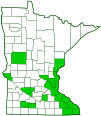western sunflower
(Helianthus occidentalis ssp. occidentalis)
Conservation • Wetland • Description • Habitat • Ecology • Use • Distribution • Taxonomy
Conservation Status |
|
|||||||
| IUCN Red List | not listed |
|||||||
| NatureServe | NNR - Unranked SNR - Unranked |
|||||||
| Minnesota | not listed |
|||||||
Wetland Indicator Status |
||||||||
| Great Plains | FACU - Facultative upland |
|||||||
| Midwest | FACU - Facultative upland |
|||||||
| Northcentral & Northeast | FACU - Facultative upland |
|||||||
Description |
||
Western sunflower is a 2′ to 5′ tall, erect, perennial forb that rises from a rhizome. The stems are erect, often reddish, and hairy near the bottom, hairless above. The leaves are mostly basal. The basal leaves are egg-shaped to lance shaped, 2″ to 8″ long, ⅔″ to 2¾″ wide, and taper gradually to a point. They are on stalks 1″ to 4″ long. The bases are wedge shaped and narrowly triangular and taper to a point. The margins are untoothed or weakly toothed. There are 3 to 8 pairs of opposite stem leaves. Stem leaves are much smaller and have untoothed margins. Basal and stem leaves are rough to the touch. The inflorescence is several flower heads in loosely-branched clusters at the ends of the stems. The flower head is 1½″ to 2¾″ wide and has 8 to 14, yellow ray florets. The underside of the rays are densely dotted with glands. The disk is cone-shaped, ⅜″ to ⅔″ wide, and has 50 or more yellow disk florets. |
||
Height |
||
2′ to 5′ |
||
Flower Color |
||
Yellow ray florets, yellow disk florets. |
||
Similar Species |
||
|
||
Habitat |
||
Dry to moderate moisture. Prairies. Full sun. |
||
Ecology |
||
Flowering |
||
July to September |
||
Pests and Diseases |
||
Sunflower bullet gall midge (Pilodiplosis helianthibulla) makes ¼″ in diameter, almost globe-shaped galls on the leaves of plants in the genus Helianthus. |
||
Use |
||
|
||
Distribution |
||||
|
Sources |
|||
| 7/28/2023 | ||||
Nativity |
||||
Native |
||||
Occurrence |
||||
|
||||
Taxonomy |
|||
| Kingdom | Plantae (Plants) | ||
| Division | Tracheophyta (Vascular Plants) | ||
| Subdivision | Spermatophytina (Seed Plants) | ||
| Class | Magnoliopsida (Dicots) | ||
Order |
Asterales (Sunflowers, Bellflowers, Fanflowers, and Allies) | ||
Family |
Asteraceae (Sunflowers, Daisies, Asters, and Allies) | ||
| Subfamily | Asteroideae | ||
| Tribe | Heliantheae (Sunflowers and Allies) | ||
| Subtribe | Helianthinae | ||
| Genus | Helianthus (sunflowers) | ||
| Species | Helianthus occidentalis (fewleaf sunflower) | ||
Subordinate Taxa |
|||
|
|||
Synonyms |
|||
Helianthus dowellianus Helianthus occidentalis var. dowellianus |
|||
Common Names |
|||
fewleaf sunflower few-leaved sunflower naked-stemmed sunflower western sunflower |
|||
Glossary
Opposite
Arranged directly across the stem from each other at the same node.
Visitor Photos |
|||||
Share your photo of this plant. |
|||||
| This button not working for you? Simply email us at info@MinnesotaSeasons.com. Attach one or more photos and, if you like, a caption. |
|||||
|
|||||
MinnesotaSeasons.com Photos |
|||||
|
|||||

Slideshows |
||

Visitor Videos |
|||
Share your video of this plant. |
|||
| This button not working for you? Simply email us at info@MinnesotaSeasons.com. Attach a video, a YouTube link, or a cloud storage link. |
|||
Other Videos |
|||

Visitor Sightings |
|||||
Report a sighting of this plant. |
|||||
| This button not working for you? Simply email us at info@MinnesotaSeasons.com. Be sure to include a location. |
|||||
|
|||||
MinnesotaSeasons.com Sightings |
|||||

|
Created: Last Updated: © MinnesotaSeasons.com. All rights reserved. |
